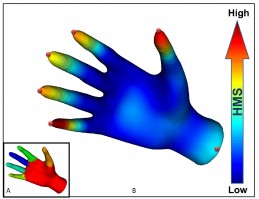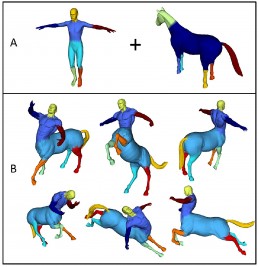How computers can mimic human 3-D vision
June 21, 2011
 a
aThe "heat mean signature" of a human hand model is used to perceive the six segments of the overall shape and define the fingertips (credit: Purdue University/Karthik Ramani and Yi Fang)
Researchers at Purdue University have developed two new techniques for computer-vision technology that mimic how humans perceive three-dimensional shapes.
The techniques, heat mapping and heat distribution, apply mathematical methods to enable machines to perceive three-dimensional objects by mimicking how humans perceive three-dimensional shapes by instantly recognizing objects no matter how they are twisted or bent, an advance that could help machines see more like people.
Both of the techniques build on the basic physics and mathematical equations related to how heat diffuses over surfaces.
The researchers tested their method on certain complex shapes, including the human form and a centaur.
“Albert Einstein made contributions to diffusion, and 18th century physicist Jean Baptiste Joseph Fourier developed Fourier’s law, used to derive the heat equation,” Professor Karthik Ramani said.
“As heat diffuses over a surface it follows and captures the precise contours of a shape. The system takes advantage of this “intelligence of heat,” simulating heat flowing from one point to another and in the process characterizing the shape of an object.

The new machine-vision technique was tested on the human form and a centaur (credit: Purdue University/Karthik Ramani and Yi Fang)
The method accurately simulates how heat flows on the object while revealing its structure and distinguishing unique points needed for segmentation by computing the “heat mean signature.” Knowing the heat mean signature allows a computer to determine the center of each segment, assign a “weight” to specific segments and then define the overall shape of the object.
The heat mapping allowed a computer to recognize the objects and also to ignore “noise” introduced by imperfect laser scanning or other erroneous data.
The methods have many potential applications, including a 3-D search engine to find mechanical parts such as automotive components in a database; robot vision and navigation; 3-D medical imaging; military drones; multimedia gaming; creating and manipulating animated characters in film production; helping 3-D cameras to understand human gestures for interactive games; contributing to progress of areas in science and engineering related to pattern recognition; machine learning; and computer vision.
Their findings will be detailed in two papers being presented during the IEEE Computer Vision and Pattern Recognition conference on June 21-23 in Colorado Springs.